Laphria astur Osten Sacken, 1877:285.
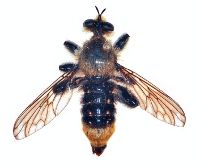 Male. Photo by S. W. Bullington |
Syntype (at MCZ) Head in Profile 14-20 mm. This species is found in the Pacific states of California, Oregon, and Washington, and inland into Idaho. L. californica is a synonym. Laphria astur is probably most similar to L. sackeni. See the notes under that species for a discussion of the differences between the two. Laphria astur resembles Bombus californiens and B. vosnesenskii, with which it is sympatric. Hardy and Preece (1927) record a larva of this species preying on a larva of the cerambycid Ulochaetes leoninus LeConte. |
Laphria asturina (Bromley), 1951:22-23 (Bombomima).
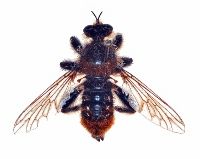 Male. Photo by S. W. Bullington |
Head in Profile
14-24 mm. This is another species found along the Pacific coast, but with a wider distribution than L. astur. It is found from California north to Alaska. This species is extremly similar to more continental L. fernaldi. It can be distinguished from that species by the possession of 1) mostly black rather than yellow pile on the first two abdominal tergites, and 2) a greater amount of black pile intermingled with the yellow on the anterior half of the mesonotal disc. |
Laphria columbica Walker, 1866:338.
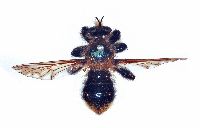 Female. Photo by S. W. Bullington |
Head in Profile
Walker gave the length of body as 9 lines. A "line" in this context is a unit of length equalling 1/12 inch. So Walker's specimen measured 0.75 inch in length, or slightly over 19 mm. This species is apparently resticted to Oregon, Washington, and British Columbia. Its range therfore does not extend as far South as that of L. astur, or as far North as that of L. asturina. It is probable that L. partitor (Banks) (q. v.) is a synonym. The only difference I can find in the two original descriptions is that supposedly in L. columbica the thorax is "clothed with short black hairs; forepart with fawn-coloured pubescence" whereas in L. partitor the thorax has "yellow hair; shorter and more sparse in front; . . .yellow hair in front of halteres and in front of wings." If the two species turn out to be identical the difference in the descriptions can probably be explained by a difference in tools; it is probable that Walker examined his specimen using only a magnifying glass, whereas Banks almost certainly used a dissecting microscope. The female specimen depicted at left was identified by J. W. Wilcox in 1942. The species supposedly resembles the bumblebee Bombus vosnesenskii. |
Laphria engelhardti (Bromley), 1931:434-435 (Bombomima).
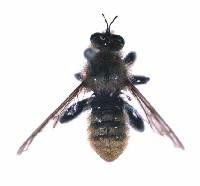 Male. Photo by S. W. Bullington |
Head in Profile
17-23 mm. The first tergite of the abdomen is always entirely black haired. The second to sixth segments in contrast are thickly yellow pilose, with red hairs mixed uniformly throughout. The closely-related L. fernaldi differs in having yellow hairs at the sides of the first abdominal tergite, and the red is confined tergites 4 and 5. And the otherwise similar L. unicolor lacks black hairs altogether. Of the three species L. engelhardti is the most southern in distribution. It is found in the mountains of southern Colorado, as well as in Arizona and New Mexico. |
Laphria fernaldi (Back), 1904:290 (Dasyllis).
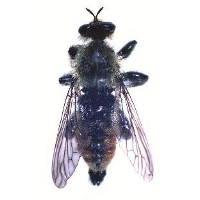 Male. Photo by S. W. Bullington |
Field Shots (On-Site) Head in Profile 15-18 mm. This species is very common along the Front Range, especially in Colorado and Wyoming. It is also found in the Great basin to the West and in reduced numbers in Oregon, Washington, and Idaho to the Northwest. Its most characteristic feature is the presence of reddish pile on tergites 4 and 5 of the abdomen. This pile entirely covers segment four, and extends along the sides and anterior margin of five. Gabritschevsky (1926) believed this red pile placed L. fernaldi into the third of three groups into which he divided North American bumbleebee models and mimics. This group, which was confined to the Rocky Mountains (referred to as the Colorado Area), all had red on the abdomen, and consisted only of Laphria fernaldi along with twelve species of Bombus namely, B. sylvicola, B. huntii, B. melanopygus, B. eduardii, B. ternarius, B. centralis, B. borealis, B. gelidus, B. flavifrons, B. rufocinctus, B. kirbuellus, and B. appositus. Laphria fernaldi is closely related to L. unicolor, which may replace it along the Rocky Mountain chain to the Northwest, and to L. engelhardti, which replaces it southwards. The latter species can be distinguished by the more even distribution of the red abdominal pile, which is not restricted to certain areas as in L. fernaldi. The identity of L. unicolor is more problematic; its distinguishing feature is the possession of an evenly yellow coat of pile, combined with the total lack of black hairs or bristles. It was originally described from "Washington Territory." Laphria fernaldi was profiled in the following technical paper: Lavigne, R. J. and S. W. Bullington. 1984. Ethology of Laphria fernaldi (Back) (Diptera: Asilidae) in southeast Wyoming. Proc. Entomol. Soc. Wash. 86(2): 326- 336. |
Laphria insignis (Banks), 1917:54 (Dasyllis).
|
Holotype (at MCZ) This species is distinguished from all of the others in the west by a combination of red hairs on the posterior mesonotum and on the scutellum. Further, the reddish pile on the posterior portion of the mesonotum contrasts with the pile on the anterior portion, which is yellow. Individuals measure from 13-18 mm long. The knowledge that the species is found in the west is courtesy of Dr. Robert Cannings, of the Royal Ontario Museum in Victoria, British Columbia. He says that it is one of two otherwise eastern species to range west of the 100th meridian. (The other is L. posticata posticata. See below for details). He has seen specimens of L. insignis from the southern and central boreal forests west to the Yukon, and believes the species is probably found in Alaska as well. Some of these specimens were taken just North of the U.S. border in B.C. The species is not common in collections from the West. I have not seen this species.
|
Laphria partitor (Banks), 1917:54 (Dasyllis).
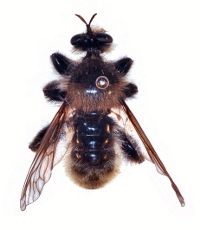 Male. Photo by S. W. Bullington |
Holotype (at MCZ) Head in Profile 18-20 mm. It is likely that this species is a synonym of L. columbica, as they look alike, and have the same size and distribution, being found in Oregon, Washington State, and British Columbia. Laphria partitor can be distinguished from both L. astur and L. sackeni by the presence of red hairs on the dorsal apices of the tibiae and tarsi. |
Laphria posticata posticata Say, 1825:374.
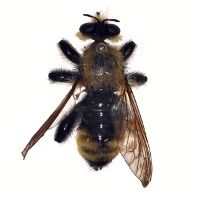 Male. Photo by S. W. Bullington |
Field Shots Head in Profile The doubling of the specific epithet here is not a misprint. This is one of two valid taxa now under the name L. posticata, which for the time being I am considering as subspecies, but which with more study will probably be awarded full specific status. The other is the eastern L. posticata scutellaris, which Bromley described from Ontario as a variety. The nominate subspecies is also found in the northeastern United States and probably in southeastern Canada. It is included here because it ranges west of the 100 meridian. In fact, it was originally described from the "North-west Territory." According to Dr. Robert Cannings, who is at the Royal Ontario Museum in Victoria, British Columbia, L. posticata posticata is found across Canada west to the Yukon, in the southern and central boreal forests. He also thinks the species may be found in Alaska. He says, however, that it's range doesn't extend very far south in the western mountains (it's in northeastern B.C,. though), and that specimens from any part of western Canada are uncommon in collections. It has the pile on abdominal tergites 4-5 all yellow, and that on tergites 6-7 all black. In the East, adults emerge in early summer, range from 12-18 mm in body length, and have been reared from larvae collected in white pine stumps. |
Laphria sackeni (Banks), 1917:54 (Dasyllis).
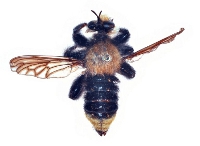 Male. Photo by S. W. Bullington |
Holotype (at MCZ) Head in Profile 15-17 mm. This species is found in Northern California and Oregon. The description could possibly include the subset of Sacken's L. astur that lack yellow hairs on the tibiae, in front of the wings, and in front of the halteres. As a rule Baron Sacken claimed these dark specimens hailed from lower altitudes than their lighter-haired brethern. Perhaps this is the reason for the name, although Banks was silent on this point. Judging from the specimens in the photogrpahs, the thorax appears more uniformly yellow in L. sackeni than in L. astur. The two descriptions make no mention of this difference. Both L. sackeni and L. astur remind me strongly of a stocky version of the eastern L. divisor. |
Laphria semitecta (Coquillett), 1910:124 (Dasyllis).
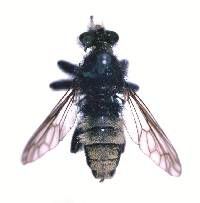 Male. Photo by S. W. Bullington |
Head in Profile
19 mm. This distinctive species was described from the unlikely location of Winnipeg, in the province of Manitoba, Canada. It appears to be fairly rare, at least in collections. It is likely this scarcity is more an artifact of collecting (or the lack of it) in such an out-of-the way location, than it is of a low, scattered population. Both males and females can immediately be recognized by having a predominately black thorax and abdominal tergites 2-6 densely covered with light yellow hairs. |
Laphria unicolor (Williston), 1884:26 (Dasyllis).
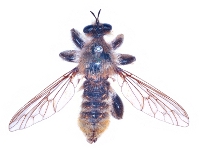 Male. Photo by S. W. Bullington |
Head in Profile
19 mm. The idenity of this species is somewhat problematic. Williston described it in 1884 from a single male, taken in the then "Washington Territory." Although the description is straightfoward enough, later assignments to the species may or may not be valid. The distinguishing feature is supposedly the complete lack of black hairs, and their replacement by yellow ones. Such a color scheme, however, could simply represent a particularly alpine form of L. fernaldi. Alpine races of otherwise lowland species are often colored lighter. The specimen at left was identified by A. E. Pritchard. |